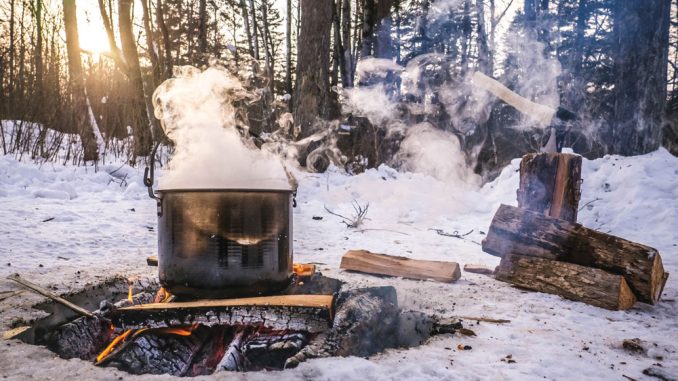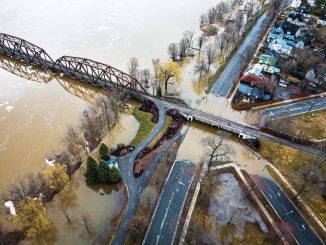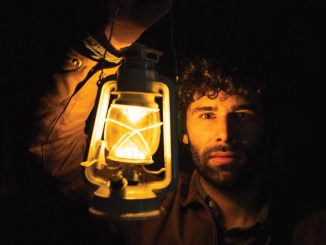
Summer or Winter, Water is Always Essential.
Editor’s Note: This is one of three sections about water we published on our Fall 2018 Prepper Manual. The other two sections are Water Wisdom and H2O Tools.
In almost all survival situations, water is of great importance. If you have a good source of clean, drinkable water, everything else becomes so much easier.
Dehydration is often thought of as a hot weather problem. When we hit the trail in the middle of summer, carrying water with us is common sense.
However, dehydration is just as much of a threat in the cold weather months. Because the air is colder and drier, we end up losing more moisture simply through breathing than we do in the summer. That vapor you see when you exhale on a cold day? That’s water vapor. When we sweat while working outdoors in the winter, that moisture evaporates quicker than in the summer, and thus, we might not notice it as easily. Our bodies don’t always let us know they’re thirsty in the winter, either.
All of that means we’re just as susceptible to dehydration when the snow flies as we are in the middle of baseball season. And it can sneak up on you if you’re not paying attention.
Feeling thirsty is just one indicator that you should be drinking more water. Urinating less often or having dark-colored urine is a sure sign you’re low on hydration. If you continue your descent into dehydration, you’ll start feeling dizzy and tired; even confused. None of these conditions is particularly helpful if you’re in a true survival situation.
When we discuss water in the context of survival preparation, there are essentially three elements at work: We need to work on determining good sources for water; how to make water fit to drink; and how to store it for later use.
1.0 WATER SOURCES
Just about anywhere you travel, there are good sources of water. Not all water is safe to drink right from the source, though. And some sources might require a little more work than others. Utilize as many sources as necessary to meet your hydration needs.
STRESS, EXERTION AND/OR EXPOSURE TO HEAT OR COLD CAN CAUSE A LOSS OR OUTFLOW OF BODY FLUIDS THAT MUST BE REPLACED QUICKLY IF YOU ARE GOING TO BE ABLE TO FUNCTION EFFECTIVELY, ESPECIALLY IN A SURVIVAL SITUATION.
1.1 Snow
When you get thirsty on the trail during the winter, it seems easy enough to grab a handful of snow and let it melt in your mouth. However, this is inadvisable. Doing so can lower your core temperature, putting you at risk for hypothermia. Snowflakes are actually tiny ice crystals. These crystals have sharp edges and can cause microscopic cuts in your mouth. Any open wound can be problematic, especially in a survival situation. You can, however, keep a clean plastic bag—one with a zip closure—in your pack. Fill it with snow, close it up, and keep it between your clothing and your outerwear. Your body heat will gradually melt the snow. Remember that you probably ought to filter it before drinking it.

Boiling water will certainly kill waterborne pathogens, but it doesn’t do anything to remove chemicals that might be present.
1.2 Ice
Ice has far more water content than the same volume of snow. But, again, you don’t want to just pop an icicle in your mouth like a candy stick. Keep in mind that you don’t know whether the water was clean before it froze. Use a campfire or some other heat source to melt ice in a pot. Then, filter or purify it before consumption.

As it falls, rain is generally safe to drink. However, it can be contaminated by whatever it falls through or lands on, so plan to disinfect it prior to consumption.
1.3 Rooftop Rainwater Collection
Assuming there’s no issue with fires or chemical or radiological fallout, rain is generally clean enough to drink as it falls from the sky. Even so, it can be contaminated by whatever it lands on or accumulates in. If your collection system is clean, and the rainwater doesn’t touch another surface prior to ending up in your container, you should be good to go. For every inch of rain that falls, approximately 0.62 gallon can be collected per square foot of rooftop. For a 1,000-square-foot roof, that’s 620 gallons of water! Something to consider is that rooftops are notoriously contaminated by dirt, debris, and animal urine and feces. Always filter rainwater collected from roofs before drinking it.

Lake ice can be a great source of water in the winter, but if it cracks and dumps you into the lake, you’re looking at major trouble.
1.4 Backyard Rainwater Collection
Purchase or scrounge four metal fence posts and a tarp. When rain is on the way, pound the four posts into the ground, forming a square. The size of the square will be dictated by the size of the tarp. Attach the tarp on one side toward the top of two posts. Then, attach the opposite side of the tarp to the middle of the other two posts so that the tarp slopes down. Tie a small weight, such as rock, in the middle of the lower edge of the tarp, creating a sort of funnel and to resist breezes. Place your collection bucket under the funnel. As rain lands on the tarp, it will flow into the bucket.
1.5 Urban Sources
If you live in an urban area, one of the best tools you can have for water collection is a sillcock key. Many storefronts and other businesses have outdoor spigots that lack handles so that non-employees can’t turn them on. A sillcock key, found at any major hardware store or online, will open those spigots. If there is water pressure in the building, you’ll be able to access it.
1.6 Water Heaters
Just about every building that is fit for human habitation, including businesses, will have a bathroom. It will also likely have a water heater. Even if the power is out, there will probably be anywhere from 20 to 50 (or more) gallons of water inside the heater. This can be easily drained into a bucket or other container via a garden hose. Attach the hose to the spigot found at the bottom of the heater, open the valve, and away you go. Depending on how long the water was in the tank, the condition of the hose and other factors, you might need to filter this water before drinking it.
2.0 DISINFECTION
Unless you can be absolutely certain the water you’ve obtained is clean and potable, consider it contaminated—and treat it accordingly. Drinking untreated water can lead to a range of issues, including severe stomach upset. This, in turn, will cause you to become even more dehydrated. Survival can be hard enough without adding a case of diarrhea to the mix.
2.1 Debris Removal
When you’re dealing with wild water sources such as ponds, streams and even collected rainwater, removing the solid debris before employing any disinfection methods will increase the working lifespan of any filtration equipment you’re using. Coffee filters work well, as do cotton fabrics such as T-shirts or bandanas. Simply pour the water through the filter to remove dirt, bugs and other floating debris.

Connecting two or three rain barrels together in a chain can help eliminate overflows.
2.2 Boiling
This is an almost foolproof way to kill the microscopic “nasties” in the water that can hurt you. Various sources indicate that water needs to boil for 3, 5, 10 or even more minutes to render water safe to drink. Here’s the real story: Waterborne pathogens, such as giardia or cryptosporidium, are killed or inactivated in under one minute at temperatures above 158 degrees (F). At sea level, water boils at 212 degrees (F). By the time water reaches the boiling point, it has already killed the pathogens. Of course, boiling temperature changes with altitude. The CDC (Centers for Disease Control and Prevention) recommends increasing the boiling time to three minutes at altitudes above about 6,200 feet, just for safety’s sake.

Ice has much more water than snow. As a result, you’ll get far more “bang for your buck” when melting it.
2.3 Water Purification Tablets
Water purification tablets come in three main varieties—iodine, chlorine and chlorine dioxide. Following the package guidelines, add the required number of tablets to the specified amount of water and wait anywhere from 30 minutes to four hours, depending on the product and the condition of the water. As a general rule, chlorine dioxide seems to work the best on the widest range of pathogens, including viruses and cryptosporidium. Chlorine dioxide can also improve the taste of the water a bit, because it causes sediment to fall to the bottom of the container.

No matter how fast the water is moving or how clean it looks, all raw water should be processed before drinking it.
2.4 Water Filtration Equipment
A water filter removes impurities and pathogens from the water. Most commonly, the filter accomplishes this by forcing the water through pores that are too small for the contaminants to pass through. Typically, these filters are made of hollow fibers or a ceramic medium. The addition of activated carbon to the filtration process can help reduce or eliminate some chemical contaminants. The filter might be gravity fed, or it might use some sort of pump to push the water through the filter.

Boiling water will kill off waterborne pathogens, but it can end up concentrating the amounts of pollutants. Using a filter that will remove chemicals is advised.
3.0 CONTAINERS AND STORAGE
When it comes to storage and transportation, water can be somewhat problematic: It is what it is—meaning that it cannot be made lighter; nor can it be compressed into a smaller size. One gallon of water will always weigh 8.34 pounds, and it will always take up 231 cubic inches of space. In spite of this, it is recommended that you carry some amount of water with you when you venture into the field. To replenish your supply, you should also have at least two different methods for rendering found water potable, such as a metal container suitable for boiling water, as well as a filtration device.
WATERBORNE PATHOGENS, SUCH AS GIARDIA OR CRYPTOSPORIDIUM, ARE KILLED OR INACTIVATED IN UNDER ONE MINUTE AT TEMPERATURES ABOVE 158 DEGREES (F).
3.1 Bottled Water
For many, bottled water might be the ideal way to stockpile water for future use. Factory-sealed water will stay fresh for at least one to two years after it is packaged. One case of 24 half-liter bottles comes to a little more than 3 gallons of water. Store it in a cool, dry, dark place. Don’t place any water storage containers directly on concrete, because over time, chemicals from the concrete might leach into the water.

Water filters are highly recommended additions to your emergency supplies. They make water disinfection a fairly simple operation.
3.2 Midsized Containers
There is a wide range of purpose-built, midsized water containers on the market. These run from 3.5 to 7 gallons in size. If you get much larger than that, you’re going to find it difficult to move them easily. Remember, water is heavy. These midsized containers are great for keeping water on hand for short-term emergencies. Look for ones that have built-in spigots to avoid having to tilt the container to empty the water.

Use coffee filters to remove sediment, bugs and other floating debris in your collected water prior to disinfecting.
3.3 Large Containers
These run anywhere from 20 to 55 gallons or more. They are great for long-term water storage. Be sure the floor on which you store them will be able to handle the weight: One 55-gallon barrel filled with water weighs almost 460 pounds. Put four barrels together, and you’re closing in on a full ton of weight!

Provided it is stored properly, bottled water will remain fresh for years.
3.4 Bulk Containers
Ranging from a couple of hundred to thousands of gallons, bulk containers might be an option for those who are confident they’ll be able to stay in place during emergencies. Tote tanks can be moved with a heavy-duty pallet jack or a forklift, while large storage tanks are going to stay put once they’re filled. These are often stored in an insulated or heated outbuilding or underground to prevent freezing.

Make sure you invest in at least a couple of good-quality water filters.
4.0 You Can Never Have Enough Water
The importance of water cannot be overemphasized. Our bodies require it to survive. We also use it for food prep, hygiene and general cleaning. In cold weather, we lose water quickly as a result of respiration and perspiration. Dehydration can sneak up on us if we’re not careful.
Regardless of the weather, bring water with you every time you venture out into the field. In addition, bring along ways to filter or disinfect water you find, just in case.

Stocking up on cases of bottled water will go a long way toward meeting your family’s hydration needs in an emergency.
At home, always have enough water on hand to provide for your family’s needs for several days. While various experts have suggested 1 gallon of water is sufficient per person per day of a crisis, that’s a very low estimate. Shoot for at least 1.5 to 2 gallons of water per person per day.
In a true survival situation, nobody has ever thought that they had too much potable water available.
Editor’s note: A version of this article first appeared in the Fall 2018 Prepper Manual print issue of American Survival Guide.





Be the first to comment